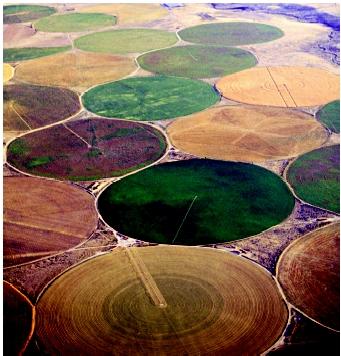Groundwater hold in aquifers is a life-sustaining resource that supplies directly water to
billions of people, for drinking, daily domestic use, agriculture and livestock. About 1.7 billion people live in areas where groundwater
resources or groundwater-dependent ecosystems are under threat because of their over-exploitation. Thus, almost one-quarter of the world’s population lives in
regions where groundwater is being used up faster than it can be replenished. Often it is a resource that was built-up under past climates as the Nubian Sand Stone aquifer under the Sahara.
Often aquifers are over-exploited in are areas in which precipitation is scare or seasonal and thus productive agriculture requires use of ground water, such as in the west of USA where agiculture is supported by the Ogallala aquifer. There use of ground water plays a central part in irrigated agriculture and rising livestock that requires large amounts of water. Likewise, presence of ground water is "just" beneficial for the health of many ecosystems, as for example it hinders intrusion of seawater into coastal plains.
 |
| Fields irrigated with water from Ogallala aquifer |
Across the
world, human civilisations depend largely on tapping vast reservoirs of water
that have been stored for up to thousands of years in sand, clay and rock deep
underground. These massive aquifers — which in some cases stretch across
multiple states and country borders — provide water for drinking and crop
irrigation, as well as to support ecosystems. Modern pumping technology and traditional property laws make water in these aquifers cheap and accessible to industrial agriculture.
 |
| Water level drop up to 40 feet (deep brown) between 1980 1nd 1995 |
The size of the global "groundwater footprint" is currently about 3.5
times the actual area of aquifers [1] because 20% of the world’s aquifers are being
massively over-exploited. For example, the groundwater footprint for
the Upper Ganges aquifer is more than 50 times the size of its aquifer.
Ukko El'Hob
[1] Water balance of global aquifers revealed by groundwater footprint; Tom Gleeson, Yoshihide Wada, Marc F. P. Bierkens & Ludovicus P. H. van Beek & Groundwater use is unsustainable in many of the world's major agricultural zones. Amanda Mascarelli, NATURE, 08 August 2012
No comments:
Post a Comment